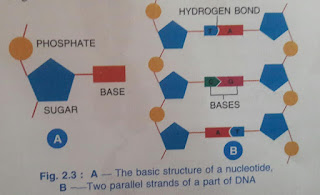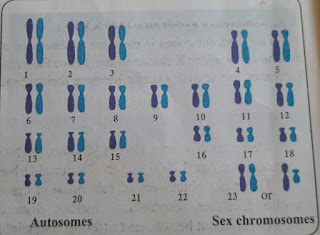DNA
Have anybody compared your appearance with your mom or dad? Why do they say so? Let's learn and try to find out some interesting facts behind this.
DNA (Deoxyribonucleic acid)is the hereditary material that is present in a unicellular organism to a complex organism such as a human being and it carries the genetic instruction in all living beings. Characters from parents are passed to offspring with the help of DNA and thus everyone says that you look like your father and mother. In scientific language, we all inherit half of our DNA instructions from our mom and half from our dad.
Interesting fact: Carls berg saw DNA for the first time and then Watson and Crick gave the double helix model. Adenine forms a hydrogen bond with thymine and guanine forms a triple hydrogen bond with cytosine.
Structure: It can be thought that DNA looks like a twisted ladder. It is described as a double-helix. Chromosome helps to keep DNA stable at the time of cell replication. The double helix structure demonstrates that DNA is a polymer of nucleotides. A nucleotide is the basic building block of nucleic acids. A nucleotide contains 3 important groups:
1. Phosphate.
2. Sugar ( Deoxyribose- 5 carbon sugar[pentose]).
3. Nitrogenous bases (adenine, guanine, cytosine, thymine).
Location: DNA is found in the nucleus of the cell as nuclear DNA. DNA is located in the nucleus of humans. Mitochondrial DNA is only a small proportion of DNA in eukaryotic cells that is present in mitochondria. There are trillions of cells inside our bodies. Each cell contains 23 pairs of chromosomes. 50 to 100 thousand genes are held within these chromosomes.
What are pyrimidines and purines?
1. Thymine forms a single ring with cytosine and this pairing is called pyrimidines.
2. Adenine forms a double ring with guanine and this pairing is called purines.
How two nucleotides are joined?
We know that DNA consists of an alternating backbone of sugar-phosphate-sugar-phosphate down the polynucleotide chain. Nucleotides are joined together by a covalent bond between the phosphate group of one nucleotide and the third carbon atom of pentose sugar in the next nucleotide and the chain continues.
--DNA fingerprinting: is a technique that shows the genetic makeup of living things and a Laboratory technique used to establish a link between biological evidence and a suspect in a criminal investigation is DNA fingerprinting.
--Advantages are as follows:
1. DNA fingerprinting provides another layer of forensic evidence and helps the legal experts to solve many such crimes which were not possible to solve before as no evidence was present. The DNA evidence in a court of law can punish or clear a suspect.
2. It offers a greater level of certainty than standard fingerprinting.
3. DNA fingerprinting is unobstructed.
--Some fun facts about DNA:
1. There are around 3 million DNA bases in our genome.
2. Paternity DNA tests compare DNA between father and child.
3. Every human being shares 99.9% of their DNA with every other human.
4. Our DNA could stretch from the earth to the sun and back~ 600 times.
Disorders due to chromosomal abnormalities:
1. Down syndrome (46+1, Trisomy of 21st Chromosome):
2. Turner syndrome (Monosomy of X chromosome):
3. Klinefelter syndrome (44 + XXY):
--Symptoms of Turner syndrome: signs of Turner syndrome at birth or during infancy may include:
1. Wide or weblike neck.
2. Low-set ears.
3. Broad chest with widely spaced nipples.
4. High, narrow roof of the mouth (palate).
5. Arms that turn outward at the elbows.
6. Fingernails and toenails are narrow and turned upward.
--Remedies for Turner syndrome: The main treatment plan for all girls and women is hormone therapy- generally an injection of recombinant human growth hormones is administered to increase the height as much as possible at proper times from early childhood until teenage.











